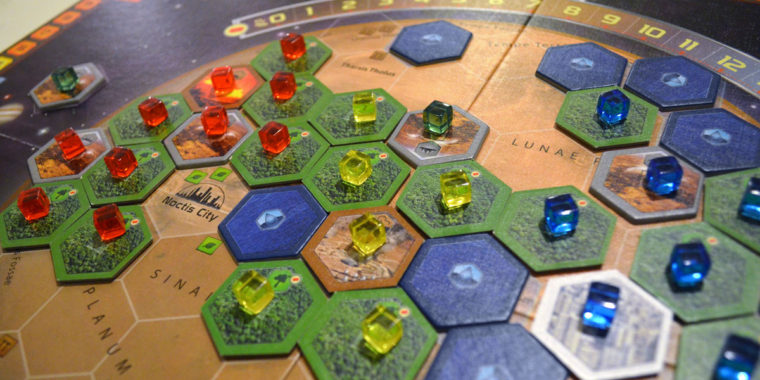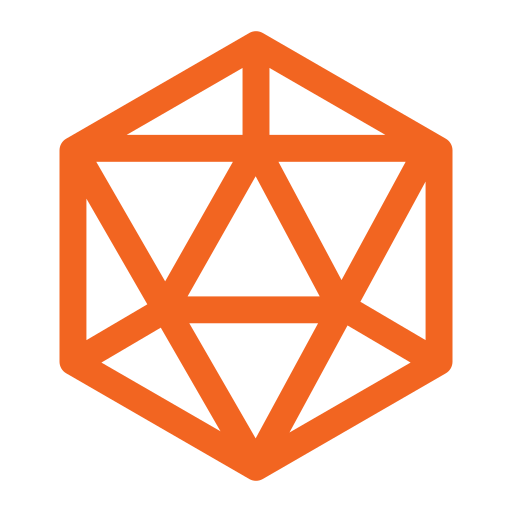Mars, a new world filled with possibilities. Mankind has the technology to bring the planet to life. Using care and thought flora and fauna can be seeded on the surface, creating a paradise for humans. Or there is always the option to just nuke everything to get the job done.
Terraforming Mars is a resource management game for 1-5 people. In it players alter the planet Mars in order to make it habitable for Earth plants and animals. They do this by managing their resource output while buying and playing a hand of cards. Actions are performed over a series of rounds, which allows players to accumulate resources or change Mars. Affecting the planet scores a player points, and the player with the most points at the culmination of the game wins.
At the start of the game each player chooses a company. Companies are unique, and provide the player with certain additional starting cards or resources, as well as an ability to use throughout the game.
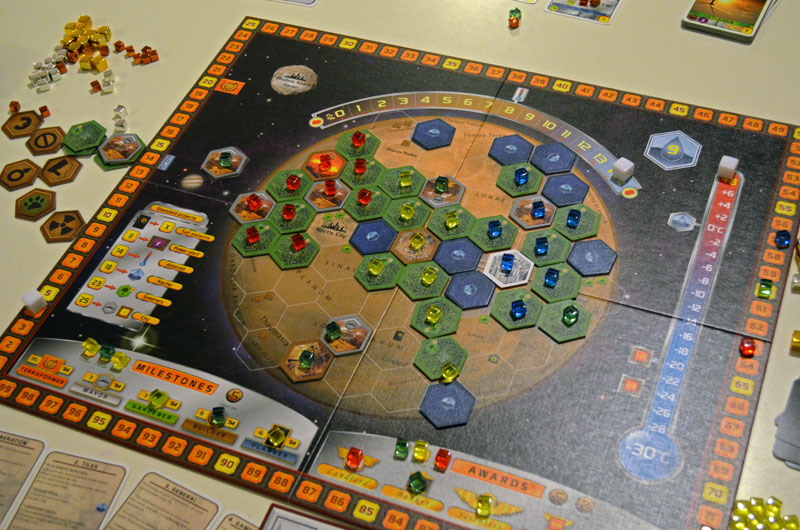
Each round players take turns performing two actions. These include the ability to play a card, or activate one already out. They can also choose from one of the six projects, such as sell a card or build a city. Lastly they can claim a milestone or fund an award, which are calculated as part of the end game scoring. After two actions are taken play moves to the next player, and continues like that until all players pass.
There are three main elements to the game; the central board, the player board and the cards. The central board contains Mars, and is where players place cities, greenery, oceans and special features. Also on the board are the temperature and oxygen level, as well as a selection of objectives. Around the outside can be found the player score track.
The temperature, oxygen level and oceans are important. There are a limited number of ocean tiles, while the temperature and oxygen levels are on numbered tracks. Once all ocean tiles are removed from the store, and the two tracks reach their ends, the game has finished. Making management of these three elements extremely important.
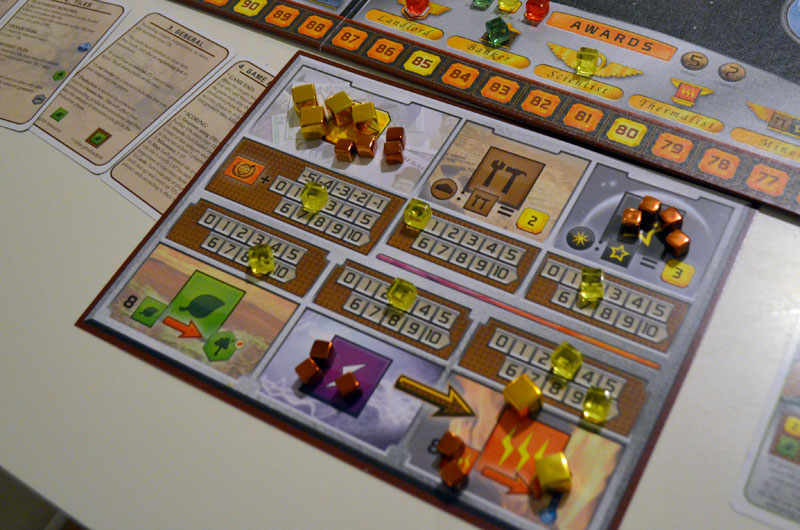
Resources are generated from, and stored on, the player board. On the board are six resource spaces, with corresponding numbered tracks. At the start of a round each player generates resources equal to the currently marked number on each resource track. This includes money, which is the total of the corresponding resource area and the player’s current score.
These resources are used to affect the game. Money is used to purchase cards, as well as play them, or activate projects. The other resources can be used to augment the purchase of some cards, while some can converted into vegetation to be placed on Mars or heat to raise the temperature. Most resources can be retained if they aren’t spent, except for energy, which is converted to heat at the start of each round.
Cards provide players with a variety of options. Each turn the players are dealt a selection of cards, which they can browse through and purchase for a fee. These purchased cards go into their hand, which contains any cards they have previously purchased but have yet to play.
Each card is unique, and they provide a variety of benefits. Some are immediate, for example granting players resource generation increases or letting them place a tile on Mars. While others are ongoing, such as letting players expend resources to effect the board or collect points for an end game scoring boost.
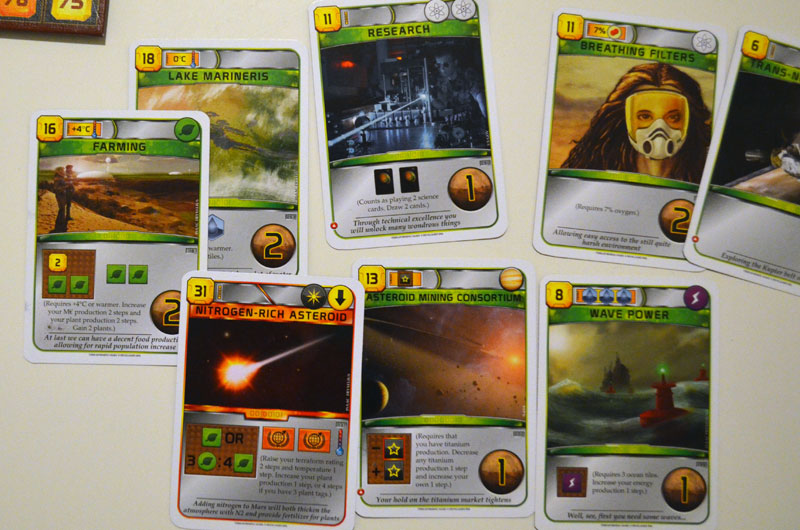
Terraforming Mars looks like a complicated game, what with its selection of coloured cubes, piles of hexes and numerous numbered tracks. And it is to some degree, as the game relies on a number of overlapping systems which cycle through and push everything forward. But once a player understands what the game wants from them it is quite easy to interpret the numerous elements.
Everything is fairly well marked, with clear icons and easily readable text. Which is good, because there is a small army of icons to keep track of. This does make communication between players important, as some cards players activate may reward other players, thanks to their ongoing cards. But this helps invest players in each other’s turns, rather than have them loose interest while they wait for their next activation.
Playing the cards, and chaining ongoing cards with newly activated cards, can be fun. It doesn’t take long for each player to build a machine for themselves, accruing resources and points while shocking the other players with surprise card plays. The variety of cards is good, and it can be tough choosing what cards to keep or discard when dealt a really good selection.
The game moves at a good pace. Creating situations that provide players with points, more often than not, advances one of the three game timers. So each decision that pushes the player further ahead also brings the game closer to finishing. Rounds also move at a good rate, with each player being allowed two actions before moving on to the next player a nice way to keep everyone involved. And since rounds end only when everyone has opted out, players will usually get to do everything they plan to.
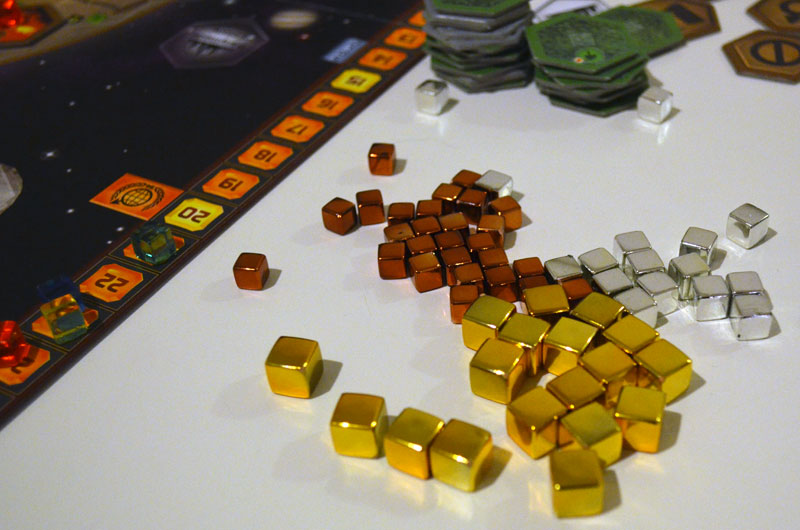
There are a lot of processes in Terraforming Mars, which are the main contributors to the problem elements. Choosing which cards to buy at the start of each round can take a while, especially as the game progresses and players have to consider not only what they have been dealt, but what cards they already hold or have played. Also the card deals are random so it is entirely possible for players to get multiple turns of cards which, largely, don’t gel with their play style or plans.
The milestones and awards can be major contributors to the end game scoring, but what their criteria is and how to acquire them isn’t as clear as most of the other parts of the game. It can be quite frustrating to try and navigate how these work mid-game, as it seems to interrupt the otherwise good flow of the rest of the game.
On the visual side of things Terraforming Mars can be hit or miss. Large portions of it has a retro video game feel with angular type and stocky boxes, which is quite endearing, though a little clunky. But this is tempered by resource cubes that are quite bland and iconography that is inconsistently designed. Not to mention the hodge podge of illustrations on the cards.
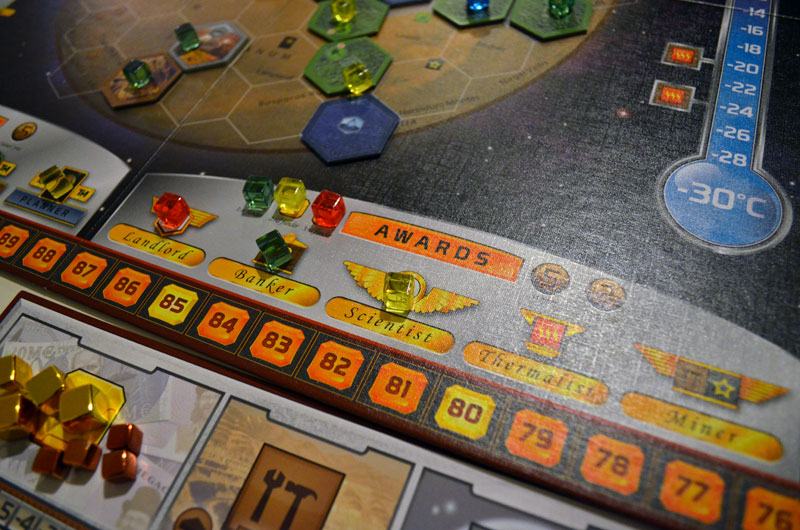
Overall Terraforming Mars provides a fun and engaging experience that is occasionally slowed by over complicated decision making processes. Games aren’t quick, closing in on two hours, but the progression of the game makes it feel like something has been achieved at its culmination. And with the clever way it has been designed to keep players engaged, even when it isn’t their turn, means that no one should get bored. Just make sure to play it with people who can handle thinking across multiple game mechanics.
Terraforming Mars is designed by Jacob Fryxelius and published by FryxGames.


